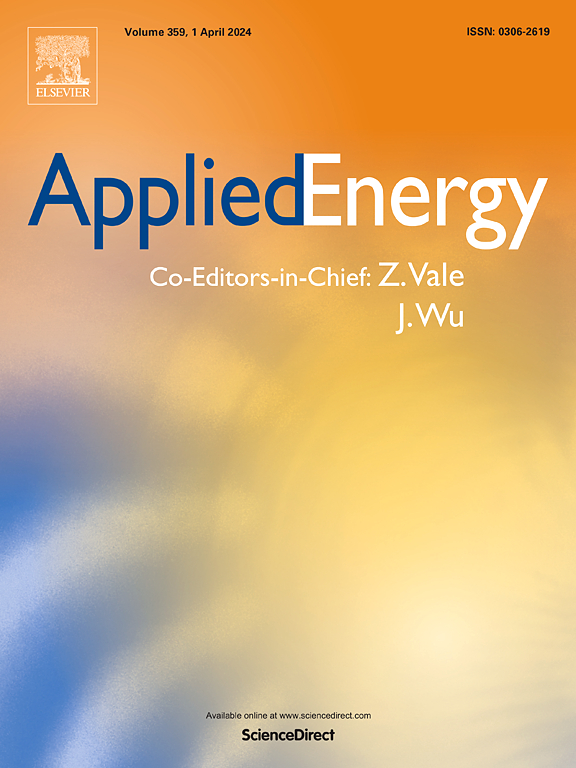Forecasting and surrogate models-based MINLP for long-term integrated design and planning of power-to-methanol
IF 11
1区 工程技术
Q1 ENERGY & FUELS
引用次数: 0
Abstract
The power-to-methanol (PtMe) process faces critical challenges, including the absence of efficient forecasting models, the lack of viable frameworks for integrated design and planning (IDP) optimization, and insufficient long-term evaluations of economic and operational flexibility. To address these research gaps, this study proposes a novel approach that integrates forecasting and surrogate models with mixed-integer nonlinear programming (MINLP) to optimize the long-term IDP of the PtMe process, with the aim of reducing production costs and enhancing operational flexibility. First, we develop two forecasting models to predict renewable energy availability over the next four years and two surrogate models to accurately represent the methanol production section. These models are then integrated with models of other sections to formulate four system models for the PtMe process. The system models are integrated with a superstructure design and MINLP to formulate four optimization problems, aiming to minimize methanol production costs. The optimization results indicate that incorporating the transformer and polynomial models with MINLP is the most effective approach, with the lithium-ion battery (LiB)-Grid-PtMe configuration emerging as the optimal design. Using the transformer model reduces the required LiB storage capacity and methanol production cost by 5.7 % and 41.01 %, respectively, while selecting an efficient design and integrating the grid reduces methanol production costs by up to 68.2 %. The findings are applicable to the long-term IDP of the PtMe process. Additionally, the proposed forecasting models and solution approach can be extended to the IDP of other power-to-liquid processes.
基于预测和代理模型的电力制甲醇长期综合设计和规划的MINLP
电力制甲醇(PtMe)工艺面临着严峻的挑战,包括缺乏有效的预测模型,缺乏可行的综合设计和规划(IDP)优化框架,以及对经济和运营灵活性的长期评估不足。为了解决这些研究空白,本研究提出了一种将预测和替代模型与混合整数非线性规划(MINLP)相结合的新方法,以优化PtMe过程的长期IDP,目的是降低生产成本和提高操作灵活性。首先,我们开发了两个预测模型来预测未来四年的可再生能源可用性,以及两个替代模型来准确代表甲醇生产部分。然后将这些模型与其他部分的模型集成,形成PtMe过程的四个系统模型。系统模型与上层结构设计和MINLP相结合,制定了四个优化问题,旨在最大限度地降低甲醇生产成本。优化结果表明,将变压器和多项式模型结合到MINLP中是最有效的方法,其中锂离子电池-电网- ptme结构是最优设计。使用变压器模型可将所需的LiB存储容量和甲醇生产成本分别降低5.7% %和41.01 %,而选择高效的设计和整合电网可将甲醇生产成本降低高达68.2% %。研究结果适用于PtMe过程的长期IDP。此外,所提出的预测模型和求解方法也可以推广到其他电转液过程的IDP。
本文章由计算机程序翻译,如有差异,请以英文原文为准。
求助全文
约1分钟内获得全文
求助全文
来源期刊

Applied Energy
工程技术-工程:化工
CiteScore
21.20
自引率
10.70%
发文量
1830
审稿时长
41 days
期刊介绍:
Applied Energy serves as a platform for sharing innovations, research, development, and demonstrations in energy conversion, conservation, and sustainable energy systems. The journal covers topics such as optimal energy resource use, environmental pollutant mitigation, and energy process analysis. It welcomes original papers, review articles, technical notes, and letters to the editor. Authors are encouraged to submit manuscripts that bridge the gap between research, development, and implementation. The journal addresses a wide spectrum of topics, including fossil and renewable energy technologies, energy economics, and environmental impacts. Applied Energy also explores modeling and forecasting, conservation strategies, and the social and economic implications of energy policies, including climate change mitigation. It is complemented by the open-access journal Advances in Applied Energy.
 求助内容:
求助内容: 应助结果提醒方式:
应助结果提醒方式:


